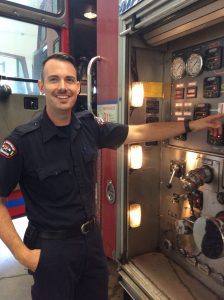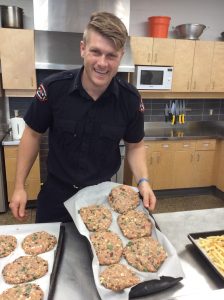Getting to know your local fire hall
The bright red pump truck waiting in the bay of Norwood Fire Station No 5 responded to over 4,000 calls last year. The ladder truck went out a further 1,300 times.
Those kind of statistics make the fire station the third busiest in Edmonton.
“The majority, over two-thirds, are in our coverage area,” said Joe McEwen, station captain and 30-year veteran with Edmonton Fire Rescue Services.
Located at 9020 111 Avenue, it’s also one of Edmonton’s oldest fire halls. The original Norwood fire station opened in 1911, followed by another on the property in 1966. That one was operational until the new station opened its doors a few blocks away in 2010. It serves an area of seven-and-a-half square kilometres and a population of 24,000.
The current staff of six firefighters and two officers attend all calls within their area including fires, medical emergencies, and technical rescues (such as bridge rescues, confined space calls, and trench collapses), as well as hazardous materials calls.
A typical day starts with a morning meeting to discuss topics like training or whether they need a replacement for the day.
“Today, for instance, some firefighters chose to teach at the training school at the west end,” said McEwen, noting that officers rotate functions. “It gives officers a knowledge base for the station’s call area.”

They also rotate across the city, with firefighters staying at a station about three years before being sent to a different location. It’s staggered, so that officers always work with staff who are familiar with the district.
“They know addresses and some of the long-time people in the neighbourhood,” explained McEwen, “They may know a particular person or home and its historical call pattern.”
One of the most familiar morning routines is mopping and vacuuming the hall. The two drivers inspect the truck for things like battery checks and flashlights.
It’s for more than just efficiency, said Captain Kevin Seutter, a 17-year veteran at the station.
“We take care of our own, it gives a sense of pride,” Seutter said. “We all have that attitude, sharing responsibility that is all ours. Things last longer and we know our equipment.”
Protocols like that are fundamental to an efficient operation.

“When on the fire ground [the scene of a fire and where fire rescue services operate] and I give instructions to someone, I know they will respond immediately,” said McEwen. “Things happen quickly on the fire ground and you have to have that discipline there.”
The Norwood team aims to leave the station in 90 seconds from the time they receive a call.
“We also get a lot of overdose calls due to fentanyl use. It’s not specific to our neighbourhood. It’s everywhere across the city,” stressed McEwen.
Another function of a fire hall is community awareness. Firefighters attend community functions and visit schools, performing fire safety walk throughs with school staff and giving fire hall tours. Like all fire stations, Station No 5 takes donations for the food bank and financial donations for the Christmas Bureau.
“We’re part of the community, it’s important to be involved and be seen,” said McEwen.
CREATE A FIRE PLAN
Edmonton Fire Rescue Services wants people to create a plan to get out of the house safely in the event of a fire.
“It’s crucial to not only have a plan, but to practice, practice, practice,” said Maya Filipovic, communications advisor with Edmonton Fire Rescue. “When it becomes second nature, that is really when we can save valuable seconds in a real emergency.”
Here are things to include in your plan:
Make a floor plan and identify at least two exits from each room.
If a window serves as an exit, ensure there’s a safe way to the ground.
Choose a meeting place, and teach everyone to report there after escaping a fire.
For more information: http://edmonton.ca/fireprevention
Featured Image: left to right: Travis Tourneur, Brayden Stauch, Matt Cherewyk, Station Captain Joe McEwen, Brian Muir, Tyler Ryan, Captain Kevin Seutter, and Scott Schetzsle. | Kate Wilson







